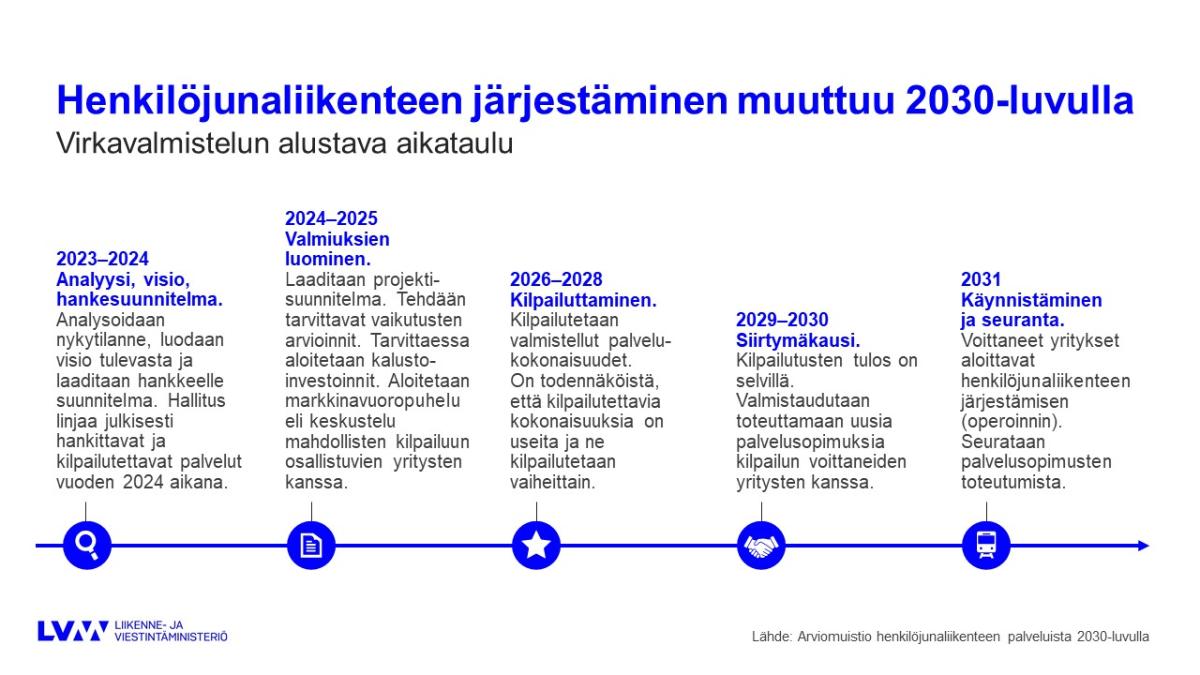Organisation of passenger rail traffic to change in 2030s: Summary of opinions on assessment memorandum

The Ministry of Transport and Communications has invited comments on the assessment memorandum concerning passenger rail services in the 2030s. The consultation period ran from 3 April to 19 May 2023. The memorandum provides a knowledge base for making decisions on the organisation of passenger rail traffic in the 2030s. The Ministry has received 75 comments.
Publicly funded passenger rail traffic will need to be reorganised in 2031 in order to achieve the agreed European Union goals. The current passenger rail service contracts expire in 2030. The next Government will have to lay down guidelines on the future passenger rail markets and services no later than in 2024. The assessment memorandum that was circulated for comments seeks to provide a knowledge base in support of this decision-making.
The assessment memorandum examines the current state and future of passenger rail service procurement. It describes the decisions that must be made in the government term starting in 2023 as well as the process for an orderly transition, by 2030, to procurement arrangements consistent with EU regulation.
Passenger rail traffic plays a major role in a sustainable transport system
The comments largely supported the memorandum’s key assessments and conclusions. Passenger rail traffic was seen as an important and growing part of a sustainable transport system. All commenters agreed that passenger rail traffic should be developed further.
While Finland’s current open access approach was generally considered to complement the transport services subject to public competitive tendering, it was not seen to be sufficient in itself. However, the current approach as such also gained some support. The open access approach allows companies to enter the passenger rail traffic market freely, but the companies need to have their own locomotives and railway carriages. Since Finland has a track gauge that is different from other European countries, rolling stock suitable for use in Finland is, for all intents and purposes, only available in Finland.
While commenters saw the State as an important player in passenger rail traffic investments, they thought regions could also get involved in financing and in planning the service level and procurement. When determining the service level for passenger rail traffic, taking into account the special regional characteristics was considered an important aspect.
There were different views on the scope of the separate rolling stock company assessed in the memorandum, a centralised tendering model receiving the most support. The comments emphasised the importance of dialogue between the parties.
The project timetable was largely thought to be realistic. However, it was considered important to maintain high standards of preparation.
What’s next?
Publicly funded passenger rail traffic will need to be reorganised in 2031 in order to achieve the agreed European Union goals.
The assessment memorandum, which public officials have prepared as part of their official duties, proposes that the Ministry of Transport and Communications should prepare the organisation of services for the 2030s between 2023 and 2025. The competitive tendering of passenger rail services would take place in 2026–2028. The operation of services under the awarded contracts would commence in 2031. The timetable and stages of the process will be refined as the project progresses.
Inquiries:
Jani von Zansen, Chief Specialist, jani.vonzansen(at)gov.fi, tel. +358 295 342 060
Emmi Nykänen, Ministerial Adviser, emmi.nykanen(at)gov.fi, tel. +358 295 342 114
Emil Asp, Director of Unit, emil.asp(at)gov.fi, tel. +358 295 342 498
Press release 4 April 2023: Assessment memorandum out for comments: Organisation of passenger rail traffic to change in 2030s
Press release 9 March 2023: Report on European Passenger Rail Markets and Services published



